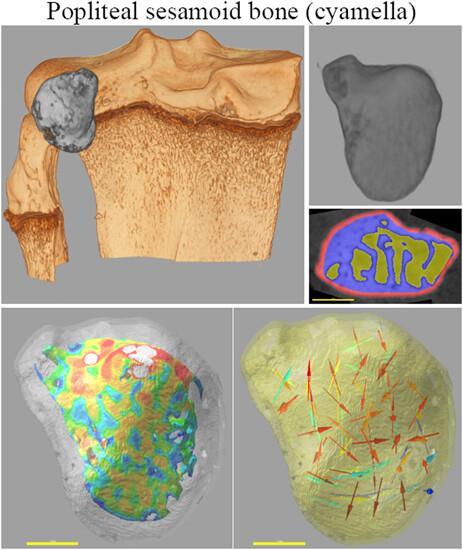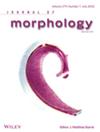新西兰白兔(Oryctolagus cuniculus)腘籽骨(cyamella)的小梁结构
IF 1.5
4区 医学
Q2 ANATOMY & MORPHOLOGY
引用次数: 0
摘要
籽骨是嵌入关节附近肌腱的骨化结构。它们由内小梁骨结构组成,周围是薄的皮质壳。虽然籽骨的形成可能主要受遗传因素控制,但籽骨的正常发育和矿化也取决于机械刺激。虽然大多数籽骨在运动过程中不直接受到其他骨骼的负荷,但它们仍然受到来自它们所嵌入的肌腱的直接力。当籽状骨仅受到来自单个肌腱的力时,例如兔的胞体,这可能为我们在相对简单的加载环境中研究骨功能适应提供了一种工具。本研究研究了新西兰白兔(Oryctolagus cuniculus)腘籽骨(cyamellae)的内部小梁结构。对5只NZW家兔后肢进行了显微计算机断层扫描,并对小梁结构和小梁结构进行了评价。结果显示,与髌骨相似,小梁骨体积分数(BV/TV)较高,主要来源于小梁骨厚度(Tb.Th)较高。小梁BV/TV和Tb。它们的分布不均匀,但在胞外较低,靠近胞内近端和中间,靠近肌腱交界处处较高。结果还表明,小梁倾向于沿两个可识别的方向排列,一个与拉伸应力方向一致,与腘肌腱一致,第二个桥接颅骨和尾侧骨皮质面之间的狭窄空间。本文章由计算机程序翻译,如有差异,请以英文原文为准。

The trabecular architecture of the popliteal sesamoid bone (cyamella) from a New Zealand white rabbit (Oryctolagus cuniculus)
Sesamoid bones are ossified structures that are embedded in tendons near articulation. They consist of an inner trabecular bone architecture surrounded by a thin cortical shell. While the formation of sesamoid bones is probably mainly controlled by genetic factors, the proper development and mineralization of a sesamoid bone depends also on mechanical stimulation. While most sesamoid bones are not loaded directly by other bones during locomotion, they still experience forces directed from the tendon in which they are embedded. In cases when the sesamoid bone is experiencing forces only from a single tendon, such as the cyamella in the rabbit, this may give us a tool to study bone functional adaptation in a relatively simple loading setting. This study investigates the internal trabecular architecture of the popliteal sesamoid bone (cyamellae) in New Zealand white (NZW) rabbits (Oryctolagus cuniculus). Five hind limbs of NZW rabbits were micro‐computed tomography scanned and the cortical and trabecular architectures of the cyamellae were evaluated. The results revealed that similar to the patella, the cyamella has a thin cortex and a high trabecular bone volume fraction (BV/TV), which is derived mostly from the high trabecular thickness (Tb.Th). Trabecular BV/TV and Tb.Th were not distributed homogeneously, but they were lower at the periphery and higher closer to the proximal and middle of the cyamella, near the musculotendinous junction. The results also demonstrated that trabeculae tend to align along two recognizable orientations, one with the direction of tensile stresses, in line with the popliteal tendon, and the second bridging the narrow space between the cranial and caudal cortical faces of the bone.
求助全文
通过发布文献求助,成功后即可免费获取论文全文。
去求助
来源期刊

Journal of Morphology
医学-解剖学与形态学
CiteScore
2.80
自引率
6.70%
发文量
119
审稿时长
1 months
期刊介绍:
The Journal of Morphology welcomes articles of original research in cytology, protozoology, embryology, and general morphology. Articles generally should not exceed 35 printed pages. Preliminary notices or articles of a purely descriptive morphological or taxonomic nature are not included. No paper which has already been published will be accepted, nor will simultaneous publications elsewhere be allowed.
The Journal of Morphology publishes research in functional, comparative, evolutionary and developmental morphology from vertebrates and invertebrates. Human and veterinary anatomy or paleontology are considered when an explicit connection to neontological animal morphology is presented, and the paper contains relevant information for the community of animal morphologists. Based on our long tradition, we continue to seek publishing the best papers in animal morphology.
 求助内容:
求助内容: 应助结果提醒方式:
应助结果提醒方式:


